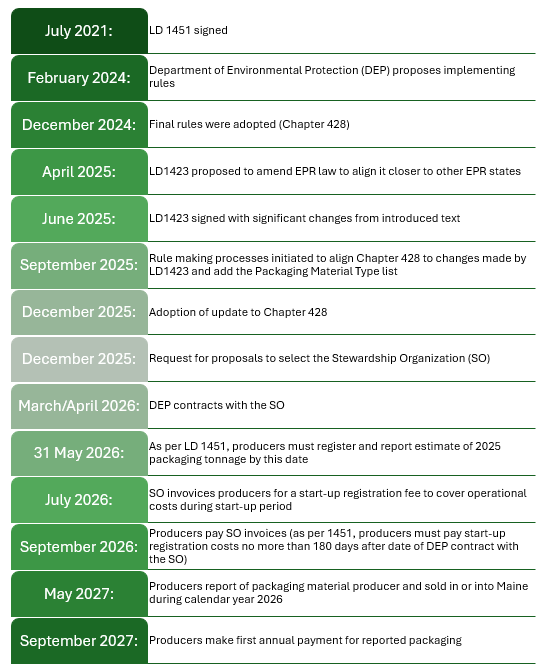What’s upcoming for packaging EPR in Maine?
by Ana Pilcher May at 15:28 in Emerging, Packaging, Environmental
When LD 1451 was signed in July 2021, Maine became the first U.S. state to enact a packaging extended producer responsibility law. Over the past four years, Maine has taken steps to implement this landmark law, including creating implementing rules, and adopting amendments to both laws and the rules.

What did the "fix-it bill" change?
As the first state to adopt packaging EPR, Maine's EPR law and model is structured differently to those introduced later in states like Oregon and Colorado. This led to pressure from industry groups to align Maine's program with these newer models. In response, LD 1423, sometimes called the "fix-it bill," was introduced in April 2025 to revise Maine's EPR framework. Environmental advocates criticized the proposal, arguing it weakened the law before it was implemented.
The original bill sought broad exemptions, including:
All B2B packaging (packaging supplied to commercial or industrial consumers)
Packaging for pharmaceuticals, dietary supplements, medical foods, medical devices, cosmetics, biologics, diagnostic kits, and medical equipment
However, these exemptions were removed during the legislative process, and the final chaptered bill differed significantly from the introduced bill.
The final law redefined "consumer" as:
"A single-family or multifamily residence, school, municipal or state government facility, public space, or commercial business that uses or partners with a municipal or state waste management service."
Under Chapter 428 rules, only packaging received by a "consumer" falls in scope of EPR in Maine. However, producers must assume packaging is received by a consumer unless the producer can verify otherwise. As the definition of consumer now includes commercial businesses that use or partner with a municipal or state waste management service, some B2B packaging may fall into scope and therefore must be reported and will be subject to fees.
Excluded from the definition of 'consumer' are manufacturers whose packaging is used as part of the manufacturing process or used for transportation to non-consumers, so long as the cost of the packaging waste management is paid for by the producer.
These updates do not clearly exempt all B2B packaging or specify which B2B scenarios fall within EPR scope. Because these definitions leave grey areas, further clarification from the Department of Environmental Protection (DEP) or the contracted Stewardship Organization (SO) is expected. The proposed updates to Chapter 428 rules, due for finalization in December, do not address these ambiguities, so guidance may come later from the SO.
In the chaptered "fix it bill", all proposed packaging exemptions were removed. Further packaging exemptions may be added in the future, but this will be via Major Substantive rule making procedure, which can take more than 1 year to come into effect.

What's next?
December
The DEP is aiming to finalize the amendments to the Chapter 428 rules this month. While no new packaging exemptions or clarifications on exempt B2B packaging are currently proposed, producers should stay alert for any last-minute changes or additions.
April
The DEP should select and contract with a Stewardship Organization. Circular Action Alliance (CAA), the selected producer responsibility organization for California, Oregon, Colorado, Maryland and Minnesota has declared its intention to respond to the DEP's request for proposals. Producer registration will follow shortly after the selection.
May
Details of the first required report remain limited. However, the DEP has indicated that producers will need to estimate the total tons of packaging produced during calendar year 2025, although which categories packaging will be required to be reported under has not been confirmed. CAA is planning to have a simplified declaration, if they are selected as the SO.
Sept/Oct
Once a SO is selected, as per the law there are only 180 days before the SO must invoice producers for the initial start-up registration costs. This means invoices will be sent around September or October.
How producers can prepare for Maine's packaging EPR:
Start collecting data on how much packaging you placed on the market in Maine in 2025
Monitor changes to the Chapter 428 rules before December – changes could affect your obligations
Watch for the selection of the Stewardship Organization in April
Once the Stewardship Organization is selected, frequently check for updates about registration portals opening and reporting information
Clarify your obligations considering brand relationships and distribution agreements
Prepare for detailed reporting by mapping your packaging data to the material categories in the Packaging Material Types List
If you have any questions about your obligations under Maine's law, or how to get your data ready and optimized ready for reporting – speak to us at Lorax EPI.
 Click here to receive regular updates on blog posts, webinars, and regulatory changes directly to your inbox
Click here to receive regular updates on blog posts, webinars, and regulatory changes directly to your inbox

